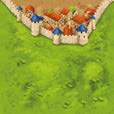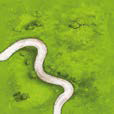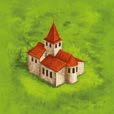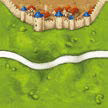Difference between revisions of "Base game"
(Following with the draft) |
(Minor grammar) |
||
| Line 1: | Line 1: | ||
Carcassonne, the world-famous French city, known for its imposing fortifications erected during | Carcassonne, the world-famous French city, is known for its imposing fortifications erected during Antiquity and the Middle Ages. This fortress, surrounded by magnificent walls, still stands today as one of the most unique French cities. In this game, players must develop the area around Carcassonne. They place their followers onto roads and into cities, monasteries, and fields. Only those who make the most judicious placements will gain the points required to win the game. | ||
=== Info on farmers rules === | === Info on farmers rules === | ||
Farmers are considered a part of the base game for most | Farmers are considered a part of the base game for most Carcassonne players. They are also used in every official tournament as they are not considered an expansion. In the new edition of Carcassonne farmers were separated as a supplement to ease access to the game for new players. WikiCarpedia follows this streamlined approach. For the sake of other expansions and the rest of the WikiCarpedia, farmers are considered a part of the base game. You can find farmers rules here [[The_Farmers]]. | ||
== Components and setup == | == Components and setup == | ||
| Line 20: | Line 20: | ||
[[File:New_rules_river.png|none|frame|Tile showing a river]] | [[File:New_rules_river.png|none|frame|Tile showing a river]] | ||
Every tile shares the same back, with the exception of the start tile and the twelve River tiles. The back of those tiles is darker, making them easy to set | Every tile shares the same back, with the exception of the start tile and the twelve River tiles. The back of those tiles is darker, making them easy to set aside. | ||
{| | {| | ||
| Line 42: | Line 42: | ||
# '''Placing a tile:''' The player '''must''' draw '''exactly''' '''1 Land tile''' from a stack and place it faceup to continue the landscape. | # '''Placing a tile:''' The player '''must''' draw '''exactly''' '''1 Land tile''' from a stack and place it faceup to continue the landscape. | ||
# '''Placing a meeple:''' The player '''may''' place a meeple from | # '''Placing a meeple:''' The player '''may''' place a meeple from their supply onto the tile they have just placed. | ||
# '''Scoring a feature:''' The player '''must''' score any feature completed | # '''Scoring a feature:''' The player '''must''' score any feature completed by the tile placement. | ||
=== The roads === | === The roads === | ||
| Line 54: | Line 54: | ||
After placing the tile, you may place a meeple as a highwayman on one of that tile’s road segments, but only if the road is unoccupied by another highwayman. | After placing the tile, you may place a meeple as a highwayman on one of that tile’s road segments, but only if the road is unoccupied by another highwayman. | ||
In our example, since the road is not yet completed, no scoring occurs (see action 3) and play moves on to the next player. | In our example, since the road is not yet completed, no scoring occurs (see action 3) and play moves on to the next player. | ||
The | |||
The next player draws a tile that he/she places to continue the landscape. They may not place a meeple on the road to the right since your highwayman is already present on that road. Instead, they choose to place their meeple as a knight in the city segment of that tile. | |||
==== Scoring a road ==== | ==== Scoring a road ==== | ||
When both ends of a road are closed, that road is completed and scored. The end of a road is closed when it meets a village, a city, a monastery, or it loops onto itself by meeting the other end. So let’s see if there is a scoring here... Huzzah! There is one because both ends of the road are closed. | When both ends of a road are closed, that road is completed and scored. The end of a road is closed when it meets a village, a city, a monastery, or it loops onto itself by meeting the other end. So let’s see if there is a scoring here... Huzzah! There is one because both ends of the road are closed. | ||
Even though it is your opponent that placed the tile, this still completes your road. How many points do you score? When scoring a road, '''each tile''' of that road grants you '''1 point'''. Here, since you scored a road that is made out of 3 tiles, you score 3 points. Well done! | Even though it is your opponent that placed the tile, this still completes your road. How many points do you score? When scoring a road, '''each tile''' of that road grants you '''1 point'''. Here, since you scored a road that is made out of 3 tiles, you score 3 points. Well done! | ||
| Line 75: | Line 78: | ||
==== Placing a meeple as a knight ==== | ==== Placing a meeple as a knight ==== | ||
Then, you see if there is | Then, you see if there is already a meeple as a knight in the city. Here, there isn’t, so you can place one of your meeples as a knight in this city. | ||
already a meeple as a knight | |||
in the city. Here, there isn’t, | |||
so you can place one | |||
of your meeples | |||
as a knight in | |||
this city. | |||
==== Scoring a city ==== | ==== Scoring a city ==== | ||
| Line 93: | Line 90: | ||
==== Placing a tile ==== | ==== Placing a tile ==== | ||
Once more, you draw a tile to continue the landscape. Monasteries are always depicted in the center of a tile. When placing such a tile, you must, as usual, make sure that it continues the illustration | Once more, you draw a tile to continue the landscape. Monasteries are always depicted in the center of a tile. When placing such a tile, you must, as usual, make sure that it continues the illustration. | ||
==== Placing a meeple as a monk ==== | ==== Placing a meeple as a monk ==== | ||
Revision as of 23:53, 4 September 2018
Carcassonne, the world-famous French city, is known for its imposing fortifications erected during Antiquity and the Middle Ages. This fortress, surrounded by magnificent walls, still stands today as one of the most unique French cities. In this game, players must develop the area around Carcassonne. They place their followers onto roads and into cities, monasteries, and fields. Only those who make the most judicious placements will gain the points required to win the game.
Info on farmers rules
Farmers are considered a part of the base game for most Carcassonne players. They are also used in every official tournament as they are not considered an expansion. In the new edition of Carcassonne farmers were separated as a supplement to ease access to the game for new players. WikiCarpedia follows this streamlined approach. For the sake of other expansions and the rest of the WikiCarpedia, farmers are considered a part of the base game. You can find farmers rules here The_Farmers.
Components and setup
Welcome to the Carcassonne universe! This rule book was conceived to allow you to learn to play the game as fast as possible. After reading it, you will be able to explain and play the game. You are going to take your first step into the universe of the modern classic that is Carcassonne. To begin, we need to set up the game, something that only takes a few brief moments. We will also take this opportunity to present the components:
The first and most important pieces of Carcassonne are the Land tiles: there are 84 tiles which depict roads, cities, and monasteries, all of which are generally surrounded by fields.
Twelve (12) of these tiles show a river. These are explained in the supplementary rules. Other graphical elements such as houses, people, or animals have no impact on the game[1].
Every tile shares the same back, with the exception of the start tile and the twelve River tiles. The back of those tiles is darker, making them easy to set aside.
Place the start tile (the one with a dark back) in the middle of the table. Shuffle the remaining tiles and set them as different facedown stacks that are easily accessible to all players.
Then comes the scoreboard, which you set to the side of your playing surface (table, floor, etc.).
Overview and goal of the game
Before diving into the explanation of this game, you should know what the goal is in Carcassonne. One after the other, players will place tiles. This is how, one tile at a time, a landscape of roads, cities, monasteries, and fields will be created and expanded. You may place your meeples on these tiles, where they will become highwaymen, knights, monks, and farmers and hopefully allow you to score as many points as possible. Points are not only earned during the game, but also at the very end. After the final scoring the player with the highest score is proclaimed the winner. And now, we are ready to begin!
Gameplay
A game of Carcassonne is played in clockwise order. Starting with the first player, the current player does the following actions in the order listed below, after which it is the next player’s turn, and so on and so forth. First, we’ll give you a brief description of the actions you have to do during one of your turns. These actions will be detailed as we present the roads, the cities, and finally the monasteries. So what are these actions?
- Placing a tile: The player must draw exactly 1 Land tile from a stack and place it faceup to continue the landscape.
- Placing a meeple: The player may place a meeple from their supply onto the tile they have just placed.
- Scoring a feature: The player must score any feature completed by the tile placement.
The roads
Placing a tile
You draw the depicted tile with three road segments starting from a village. You must place it in such a way that it continues the existing landscape (the tiles already in play).
Placing a meeple as highwayman
After placing the tile, you may place a meeple as a highwayman on one of that tile’s road segments, but only if the road is unoccupied by another highwayman.
In our example, since the road is not yet completed, no scoring occurs (see action 3) and play moves on to the next player.
The next player draws a tile that he/she places to continue the landscape. They may not place a meeple on the road to the right since your highwayman is already present on that road. Instead, they choose to place their meeple as a knight in the city segment of that tile.
Scoring a road
When both ends of a road are closed, that road is completed and scored. The end of a road is closed when it meets a village, a city, a monastery, or it loops onto itself by meeting the other end. So let’s see if there is a scoring here... Huzzah! There is one because both ends of the road are closed.
Even though it is your opponent that placed the tile, this still completes your road. How many points do you score? When scoring a road, each tile of that road grants you 1 point. Here, since you scored a road that is made out of 3 tiles, you score 3 points. Well done!
It is now time to note your score. You keep track of your score with the meeple you placed on the scoreboard before starting the game. Continuing our example, you move it forward 3 spaces to show that you’ve scored 3 points. Note: if your score passes 50 points, lay down your scoring meeple to show your 50+ points. After each scoring, return to your supply the meeple that was just scored.
That’s it! We’ve already seen the most important parts of the game. Now, we will further expand on those actions by showing you how they apply to the other features, namely the cities and the monasteries:
The cities
Placing a tile
As usual, you draw a tile that you use to continue the landscape. Of course, the illustration must be continued as well. For example, a city segment must be connected to an open city.
Placing a meeple as a knight
Then, you see if there is already a meeple as a knight in the city. Here, there isn’t, so you can place one of your meeples as a knight in this city.
Scoring a city
Let’s continue our example and assume that a few turns have passed. You now draw this tile that you place to continue your city. Since the tile you’ve placed completes a feature (here, the city), it must now be scored. A city is completed when it is surrounded by walls and there are no gaps inside the city. Since you have a meeple in the completed city, you are the player to score it.
Each tile in a completed city is worth 2 points. In addition, each coat of arms is worth 2 more points. For this city, you score 8 points! As usual, the meeple that was in the scored feature returns to your supply.
The monasteries
Placing a tile
Once more, you draw a tile to continue the landscape. Monasteries are always depicted in the center of a tile. When placing such a tile, you must, as usual, make sure that it continues the illustration.
Placing a meeple as a monk
You can place a meeple on a monastery as a monk. Of course, that meeple must come from your supply.
Scoring a monastery
A monastery is completed when it is surrounded by tiles. During scoring, the monastery is worth 1 point per tile that completes it (including the monastery itself).
Perfect! By placing this tile, you complete your monastery. It earns you 9 points and allows you to take your meeple back.
Summary
And voilà! We have already seen most of the rules for Carcassonne. There are only a few points left to see, but first, here is a summary of what we’ve seen so far:
Placing a tile
- You must place your drawn tile in such a way that it continues the landscape and the illustration.
- In some very rare cases, it may be impossible to place the tile. In those cases, simply return the tile to the box and draw a new one.
Placing a meeple
- You may place a meeple on the tile you’ve just placed.
- You may not place a meeple in a feature where there already is at least one other meeple.
Scoring a feature
- A road is completed when both ends lead to a village, a city, a monastery, or the road forms a loop. Each tile in a completed road is worth 1 point.
- A city is completed when it is surrounded by walls and there are no holes inside the city. Each tile in the completed city is worth 2 points. Each coat of arms in the completed city is worth an extra 2 points.
- A monastery is completed when it is surrounded by 8 tiles. Each of the monastery’s tiles (the 8 surrounding tiles and the one with the monastery itself) is worth 1 point.
- Scoring always occurs at the end of a player’s turn. At that moment, each player with a meeple in a scored feature earns points.
- After each scoring, return to your supply the scored meeples.
- If there are multiple meeples in a single scored feature, the player with the most meeples is awarded full points and all other players receive nothing. When more than one player have the most meeples in a scored feature, the tied players all score full points.
Many meeples in the same feature
Game end and final scoring
Sadly, all good things must come to an end, and the same goes for a game of Carcassonne. You may wish that it were otherwise, but there must be a winner! Thus, the game ends immediately after the turn of the player who placed the last tile. Then, players proceed to a final scoring, after which the winner will be known to all!
Once the game is over, all meeples still in play are scored:
- Each incomplete road is worth 1 point per tile, just like during the game.
- Each incomplete city is worth 1 point per tile and 1 point per coat of arms, which is only half the points.
- Each incomplete monastery is worth 1 point plus 1 point per adjacent tile, just like during the game.
- Each field is worth 3 points per adjacent completed city.
Once the final score is known, the winner is the player with the most points. Congratulations on winning your first game of Carcassonne!
Footnotes
- ↑ They have no impact considering the base rules. They are or in some case probably will be used in expansions.





